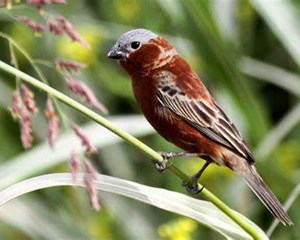Genetic sequencing shows just how similar these species are. Only 12 of their genes differ—less than 0.1% of their genomes. Intriguingly, one of the 12 is part of one of the sex chromosomes, hinting at a role for sexual selection. Another three of them play a role in the colouration of male plumage, which is also suggestive. For, although the species are of similar sizes and shapes, adult male tawny-bellied seedeaters, as their name implies, have brownish-orange chests, while male Ibera seedeaters have black throats and sandy-coloured bodies. Their songs are distinct, too. They use the same range of frequencies, but different syllables.
基因測序顯示了這些物種的極度相似性。他們只有12個基因不同——不到基因組的0.1%。有趣的是,這12條染色體中有一條是其中一條性染色體的一部分,這暗示了性選擇的作用。另外三條對雄性羽毛的顏色也有影響,這也很有啟發性。因為,盡管這兩個物種的大小和形狀相似,但成年雄性茶腹食籽雀(如它們的名字所示)的腹部是茶色的,胸部是橙色的,而雄性伊比利亞食籽雀的喉嚨是黑色的,身體是沙色的。此外它們的鳴囀也截然不同,使用的頻率范圍是相同的,但音節不同。
First, Ms Turbeck and her colleagues established that females of both species did, indeed, regularly select the right mates. Observation of pairs suggested so, and genetic testing of young (needed because more than half the females under study mated with extra males in addition to their long-term partners) did not find any exceptions, either. That done, they looked at males' abilities to distinguish conspecific rivals from heterospecific neutrals. During the 2019 breeding season they mounted decoy males in the territories of 40 male tawny-bellied seedeaters and 36 male Ibera seedeaters. They then monitored the residents' responses when a female was around.
首先,圖貝克女士和她的同事證實了一點,即這兩個物種的雌性確實會定期選擇合適的配偶,對配偶的觀察也證實了這一點,而且對年輕配偶進行的基因檢測(需要做是因為在研究中有超過一半的雌性除了長期伴侶外還與其他雄性交配)也沒有發現任何例外。研究完成后他們觀察了雄性區分同種對手和異種中性對手的能力。在2019年的繁殖季節,他們在40只雄性茶腹食籽雀和36只雄性伊比利亞食籽雀的領地上安置誘餌雄性。然后,當有雌性在附近時,他們監測“居民們”的反應。

They used four decoys. One had the plumage and song of a male Ibera seedeater. One similarly resembled a male tawny-bellied seedeater. The other two had, in one or other combination, the appearance of one species and the song of the other.
他們用了四種誘餌。一種有著雄性伊比利亞食籽雀的羽毛和鳴囀,一種和雄性茶腹食籽雀相似。另外兩種在一種或另一種組合下有著一種物種的外表和另一種物種的鳴囀。
If a resident male viewed a decoy as competition he would act aggressively, by flying to and pecking at it. And males could certainly tell the difference. They were most aggressive towards decoys that resembled their own species, moderately so towards decoys that combined features of both, and least towards those that resembled the other species. Since these were not real birds, it must have been the colouration and the song that were the cues.
如果一只雄性居民把誘餌視為競爭對手,那么他會飛過去啄它,表現得很有攻擊性。雄性當然能分辨出區別。它們對與自己種類相似的誘餌最具攻擊性,對結合了兩者特征的誘餌的攻擊性較弱,而對那些與其他種類相似的誘餌的攻擊性最低。既然這些不是真正的鳥,那么顏色和鳴囀一定就是線索。
The differences between the species' songs may be cultural, and have come about after the split. But the differences in plumage are clearly genetic. What is more, they are so small that they could have happened on a single occasion as a result of an accidental hybridisation, for similar genetic differences are found in varying combinations throughout southern capuchino seedeaters. Also, what happened once could presumably have happened often. It therefore seems plausible that Ms Turbeck has uncovered the nub of the mechanism by which this group has become so diverse. If so, then she has helped write another page in that as-yet-unpublished volume, "The Real Origin of Species".
這兩種物種間鳴囀上的差異可能是由文化造成的,而且是在物種分裂之后產生的,但羽毛上的差異顯然是遺傳的。更重要的是,差異如此之小,所以可能是偶然雜交的結果,因為在南部卡布奇諾食籽雀的不同組合中發現了類似的基因差異。而且,曾經發生過的事情可能會經常發生。因此,圖貝克女士揭示了這一群體變得如此多樣化的核心機制似乎是合理的。如果是這樣的話,那么她又能在尚未出版的《物種的真正起源》一書中再添上一頁了。
譯文由可可原創,僅供學習交流使用,未經許可請勿轉載。











